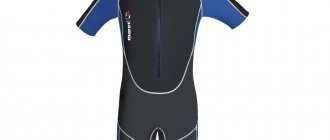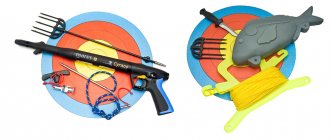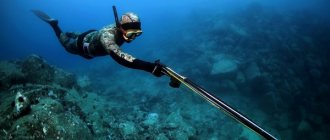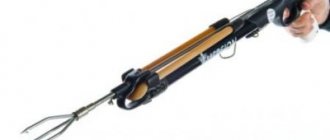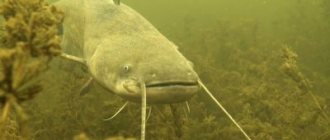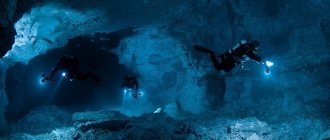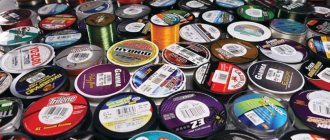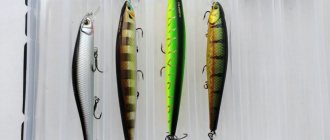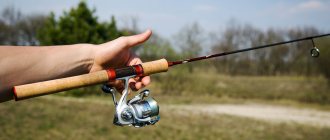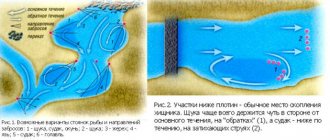It would seem that these fins are nonsense. Whether it’s a mask or a wetsuit. There are more complaints about them: that the viewing angle is good, that the suit fits well, and that the color suits everything without fail. Indeed, the functionality of the mask and wetsuit is of fundamental importance. It affects the comfort of being in the water and often determines the speed of the submariner’s reaction.
But fins are far from the last attribute of equipment for spearfishing. After all, they are the blades of our legs, that is, the motor when moving. What fins should you choose for underwater hunting?
What do fins affect:
- on how much energy the hunter will spend when moving underwater;
- depends on whether the hunter will need more or less air when performing certain underwater maneuvers.
This means that if the fins do not have very high efficiency, then:
- some of the leg energy will be lost;
- movement in water will be less efficient;
- you will need to surface more often for new air.
By choosing fins wisely, we will eliminate these life-aggravating moments, save energy and hunt efficiently.
Material of manufacture
Fins are made from the following materials:
- plastic;
- fiberglass;
- composite of a fiberglass base and a top layer of carbon (sandwich carbon);
- carbon
The materials are listed in order of increasing swimming characteristics and, accordingly, cost:
- plastic – up to $30;
- fiberglass – up to $60;
- composite – up to $100;
- carbon - up to $600.
To be fair, it should be noted that plastic fins can be found at the same price as composite ones. Since the cost is also influenced by other factors, which we will consider below.
Plastic models have the lowest efficiency of all materials, which is explained by its physical characteristics. Fiberglass exhibits greater elasticity and is a more natural “extension” of the leg. The use of carbon adds lightness to elasticity, which further increases the efficiency of the underwater hunter’s movement. The exclusively carbon blades are so light that they are practically unnoticeable when moving.
The shape of the blades, the angle of bending of the blade and its absence.
Considering the shape of the blades, you can notice that rarely does anyone produce simply smooth and even models; manufacturers strive to give the shape in the form of waves, make holes of various shapes and other manipulations.
Most often, waves on the blade can be found on fins without a flange on the blade. This is because during operation, the water tends to go in the direction of least resistance and the blade of the fins tends to “fall” in any direction. If the leg muscles are not sufficiently trained or the hunt has been going on for a long time and the legs are simply tired, the fin will “walk” in the water column without pushing the water from the toe to the end of the blade. The flange tends to direct water along the blade and reduce yaw, but the flange makes the blade more rigid and this must be taken into account. Any holes reduce water resistance when rowing, which makes hunting more comfortable.
Notice how the flipper “falls” inside the foot. If it weren’t for the flanging, then most likely the blades would touch each other, disrupting the rhythm.
Recently, there has been a tendency to abandon flanging; this point should not be confusing.
The angle of bend in the butt is a wonderful gift from manufacturers to all those who are not sufficiently trained or spend a long time in the water. The fact is that for the most effective stroke, the fin should be an extension of the leg. In trained swimmers, the ankle is stretched and the fin, without bending at the butt, has a straight line from the hip to the very tip of the blade. For an untrained person, doing this is almost impossible.
Butt angle using UP-F1 fins as an example
There is also a factor of fatigue. Underwater hunters spend many hours in the water, during which they actively move. It is very difficult to keep the muscles tense for a long time, stretching the toe, the leg will get tired and the muscles will involuntarily relax.
Manufacturers have taken all these nuances into account and offer fins with a bend in the butt of the overshoe. The greater the bend angle, the less effort will have to be expended to maintain the effective plane of the fin.
I personally recommend not to think that the bend angle will indicate some kind of lack of training or lack of experience and to choose fins only with a bend in the butt with the maximum possible angle. This will allow you to enjoy a comfortable stay in the water for as long as possible, even with very active swimming.
Length
A large length - 75 cm or more - is traditionally necessary for situations where speed development is required. This applies primarily to divers. Can be useful for deep sea hunting. More force is required to move in such fins.
For most midland hunters diving into lakes and rivers, fins that are too long are not needed. Speed is not very important. But maneuverability when hunting is required. For better maneuverability, choose small and medium models – up to 65 cm in length.
Open or closed heel
Despite the fact that all spearfishing enthusiasts prefer fins with a closed heel, the question of which is better remains a matter of debate.
The advantages of a closed heel are obvious:
- such fins sit more stable on the leg;
- There is no risk of the straps and fastenings of the fins getting caught on grass, reeds, nets and other underwater obstacles.
There is also a minus: options with a closed heel require precise selection of the size. This is not a problem if you always hunt in the same conditions. You buy some fins (or galoshes) and use them.
But if you want, for example, to hunt in late autumn or winter, when you will be wearing thick socks and boots, which give an additional about 1 cm to the size of your feet, but summer fins, which should fit tightly on your feet, will no longer be suitable.
Pros of galoshes with open heels:
- have great variability in leg size - a size fluctuation of 1-2 cm will not be critical;
- can be used both with and without bots;
- the strap secures the leg firmly enough;
- the probability of losing such a fin is no greater than being thrown out of completely closed galoshes;
- they are more compact and lighter.
Don't treat fins with adjustable heels like a child's toy. The well-known manufacturer of fins for spearfishing - MARES - has in its assortment a couple of dozen compact (40-50 cm) models with an open heel.
They are all high-tech products that incorporate innovative ideas to make scuba diving more economical and efficient.
For example, in some models, a soft rubber insert is made in the middle of the blade, which acts as a membrane between the toes of amphibians, creates a more powerful flow of water and puts less strain on the legs.
In terms of price, fins with an open heel are often superior to classic closed versions. The already mentioned open Mares models made of plastic and rubber cost $100-$200, which is quite comparable to the cost of fiberglass and composite products.
Convenience of galoshes
It’s like with shoes: they should be comfortable, they shouldn’t be too tight or loose on the foot. It should be taken into account that you may have to hunt in different climatic conditions, in which you will need to additionally insulate your legs and, accordingly, increase the size. If we talk about hunting in cold water, it is better to choose overshoes made of thermal rubber, which provide additional warmth to the feet.
To avoid slipping on stones and other poorly traction surfaces, you need to choose galoshes with a ribbed sole, “with a pattern.” Not all models are equipped with such soles.
Model selection
When engaged in diving, underwater sports or hunting, a person experiences the effects of water on his body for a long time and is forced to protect his body from hypothermia.
It is for this purpose – heat preservation and thermal insulation – that a high-quality and reliable wetsuit is needed.
At the same time, it is important not to overheat in the suit itself, so before purchasing you should determine the water temperature in order to select the appropriate type of wetsuit, its thickness, design and additional elements.
Types of wetsuits
Thanks to special cuffs on the arms and neck, as well as water- and gas-tight zippers, the suit almost completely prevents water from getting inside. This is the most airtight equipment, ideally retaining the heat of the human body.
The thickness of such a suit ranges from 5 to 15 mm, it is quite heavy, hinders movement, but at the same time ensures safety when immersed in water whose temperature is below zero. Special air valves inside the suit facilitate movement and create comfort. Additionally, dry suits are equipped with boots and a helmet.
The purpose of a dry wetsuit is long-term stay under water, as well as professional work that does not require activity.
Advantages:
- maximum tightness;
- possibility of combination with thermal underwear;
- high strength.
The name is explained by the peculiarity of the equipment - its design involves the ingress of water, which is heated by the heat of the human body and thereby provides thermal insulation. Water circulation under the suit should be kept to a minimum, so choosing the right size is important.
This type of equipment is the most inexpensive, comfortable, its thickness is from 1 to 5 mm, which provides a certain mobility, as well as protection at water temperatures from 16 to 24 degrees. Thinner wetsuits are usually designed for swimming in warm water above 30 degrees.
At the same time, the equipment protects the skin from possible damage.
Advantages:
- large selection of different configurations;
- light weight;
- elasticity;
- affordability.
Flaws:
- Sometimes it becomes necessary to use a special gel to make putting it on easier.
This is a combined type of wetsuit that combines the characteristics of the two above. It is denser than a wet suit, but at the same time allows a small amount of water to pass through its shell, and thermal insulation depends on the degree of fit of the suit to the body. The thickness of the equipment ranges from 3 to 7 mm for water temperatures from 10 to 20 degrees.
Advantages:
- retains heat well even in cool water;
- lightness and strength;
- provides maximum freedom of movement;
- protects skin from damage.
Flaws:
- equipment is designed for no more than 2 hours in the water.
Wetsuits are made from three main materials: neoprene, trilaminate and rubberized fabric. The texture of these fabrics is as close as possible to the skin of animals of the underwater world, sharks or dolphins. The materials are highly durable and elastic; for ease of putting on, they are covered on both sides with nylon or jersey; some models are covered on the inside with plush.
Read more: Modern anti-aging facial massagers
Based on their design and structure, the following types of wetsuits are distinguished:
- Monosuit. It is a solid overalls that fits the legs and arms along the entire length, and additionally the head with the help of a neoprene helmet. The thickness of such suits is from 3 to 5 mm.
- Short monosuit. In other words, it is a one-piece suit without a helmet, with short sleeves no lower than the elbow and legs that reach mid-thigh. Thickness is about 1 – 3.5 mm.
- Separated. This is the most suitable wetsuit for spearfishing, which consists of a suit with straps (Long John) and a zip-up jacket with long sleeves and a helmet. The thickness of the vestment is from 5 to 9 mm.
- Combined. This equipment combines elements and details of the above types of wetsuits. This is usually a combination of a one-piece suit, helmet and jacket, or a cropped one-piece suit with long sleeves and a sleeveless one-piece suit. Combined clothing provides maximum heat retention due to its multi-layered nature.
The choice directly depends on the type of use of the wetsuit, the conditions of its use (location, water temperature and other parameters), as well as on what price is most acceptable.
When choosing a wetsuit, you must consider the following characteristics:
- Material;
- Anatomically accurate tailoring;
- Suitable thickness;
- Positive buoyancy;
- Elasticity;
- The presence of inserts that provide freedom of movement;
- Availability of protective knee pads;
- UV protection;
- Position of the zipper.
Equipment of this type is designed for water temperatures from 23 to 30 degrees, and is made of neoprene and mixed synthetic fabrics such as polyamide and elastane.
Such materials should improve buoyancy, reduce the resistance of the aquatic environment, not impede movement, fit well to the body, but not interfere with blood circulation. The thickness is usually from 0.5 to 5 mm.
The design can be anything, from a monosuit to a shortened version, as well as for women and children.
Aqua Sphere AQUA SKIN SHORTY
Advantages:
- combination of comfort and tight fit of the suit to the body;
- improved swimming;
- variety of models.
Flaws:
- Aqua Sphere AQUA SKIN SHORTY. A short men's suit with a thickness of 0.5 to 1 mm, average cost - 13,725 rubles.
- HUUB Aegis 2. Women's highly elastic monosuit worth RUB 17,164.
- Speedo lzr racer elite 2. Women's racing suit with silicone layer. The average price is 18,500 rubles.
These are the smoothest suits of dry, wet and semi-dry types, solid or separate, distinguished by a wide variety of color designs that replicate natural shades. These can be black and brown, gray, olive tones, as well as camouflage (simple and three-dimensional).
Salvimar Wet Drop Cell
Advantages:
- maximum thermal insulation;
- quick drying.
Flaws:
- suits that are thick will form folds during storage.
- Mares EXTREM 70. Two-piece suit, 7 mm. Average price - 9,410 rubles.
- Salvimar Wet Drop Cell. Wet two-piece suit, lined with nylon on the outside. Thickness 7 mm, price - 9,900 rubles.
- Aquadiscovery CALCAN. Russian-made two-piece suit. Thickness 5 mm, cost - 14,535 rubles.
Wetsuits for spearfishing
Suits of this type are designed for water temperatures below 10 degrees. They come in dry and wet types, single-piece and two-piece designs with a built-in helmet. As a rule, they have thick padding on the back, as well as in the chest and groin area, and the seams are additionally taped. The wetsuit kit includes boots, socks and gloves.
Read more: AV-Test: The best antiviruses for Windows 10 – August 2019
OMER Gold Black
Advantages:
- high thermal insulation, protection against hypothermia and injury;
- the ability to stay in cold water for a long time.
Flaws:
- need for careful storage.
- OMER Gold Black. Wetsuit, 7 mm. Average price - 12,000 rubles.
- SARGAN Neman RD2. Wet type equipment, 0.9 mm thick, costs 14,900 rubles.
- Henderson Thermoprene. Wet suit, 7mm, cost RUB 22,000.
Wetsuits for cold water
This professional seamless sports equipment is called a starter.
The peculiarity of such suits is that they increase swimming speed, and combined fabrics, for example, Teflon, are used for their manufacture.
There are men's, women's (usually with an open back, or with a zipper on the back) and children's. By design, these are closed overalls, suits with short sleeves and trouser legs (to the knees), as well as hydropants and hydroshorts.
Arena Carbon Ultra
Advantages:
- improvement of muscle tone;
- anatomical cut;
- improvement of hydrodynamics;
- maximum comfort.
Flaws:
- small range of colors.
- Arena Powerskin Carbon Pro Jammer. Men's hydroshorts, the average cost of which is 14,590 rubles.
- Arena Carbon Ultra. Women's suit with an open back. The average cost is 20,400 rubles.
- Arena Powerskin Full Body Short Leg. Short suit with Teflon coating, average price - 28,800 rubles.
Wetsuits for swimming in the pool
Most often this is wet-type equipment, which is short or long overalls with a built-in helmet. In addition, this vestment is equipped with a special seal in the groin area, on the chest, as well as seals on the wrists and ankles. There are pads on the knees and elbows, and soft neoprene inserts on the sides.
Mundial Elaskin Beuchat
Advantages:
- high thermal insulation;
- quick drying.
Flaws:
- Mundial Elaskin Beuchat. Inexpensive elastic men's monosuit, 7 mm, costing RUB 2,776.
- Technisub Walea. A two-piece suit made of neoprene 5 mm thick costs 7,000 rubles.
- Marlin Prestige Beuchat. Comfortable soft combination wetsuit, 5 mm. Average cost – 10,000 rubles.
Fishing wetsuits
Usually these are wet suits that have a special anatomical cut. They are equipped with additional padding on the chest and shoulders, as well as soft inserts on the sides and in the armpits. They come in separate and continuous versions, are made of highly elastic neoprene, and have convenient zippers to facilitate the process of putting on and taking off.
HENDERSON Aqualock
Advantages:
- designed taking into account the characteristics of the female body;
- comfortable putting on;
- variety of colors;
- lightweight material.
Flaws:
- models for cold water and fishing are practically not found.
- Mares Manta. Inexpensive shortened equipment, 2.2 mm, average price - 6,294 rubles.
- Mystic 2015 Diva 5/4 D/L Fullsuit Front zip Women Teel. Very light monosuit, 5 mm thick, costing RUB 26,000
- HENDERSON Aqualock, Dry monosuit, 5 mm. Average price – 34,320 rubles.
Women's wetsuits
Designed for water temperatures from 16 to 0 degrees. This vestment of all types is made of thickened neoprene, two-piece construction, equipped with elbow and knee pads, as well as reinforced seams.
Read more: Which dish is better to buy for a TV: TOP 7 best options for watching satellite TV || 6 best satellite TV sets
Sargan Neman RD2
Advantages:
- protects from cold for a long time;
- easy to put on;
- large selection of colors.
Flaws:
- Wearing such a suit requires training.
- Beuchat Mundial Equipment. Two-piece wet suit, 9 mm thick. Average price 14,640 rubles.
- Sargan Neman RD2. Combined equipment, 0.9 mm, costing RUB 14,998.
